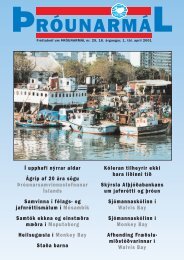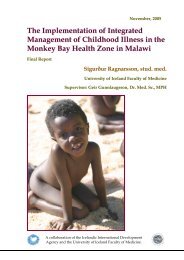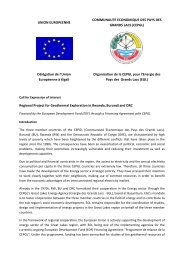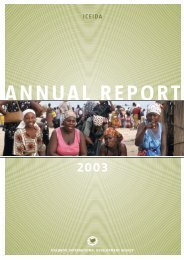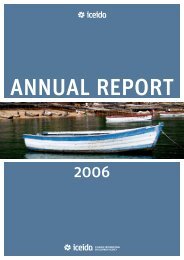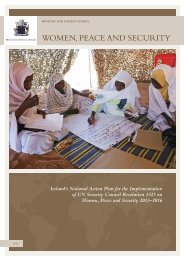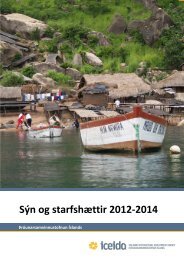Mangochi-ICEIDA-Partnership-in-Public-Health-2012-2016-Part-II ...
Mangochi-ICEIDA-Partnership-in-Public-Health-2012-2016-Part-II ...
Mangochi-ICEIDA-Partnership-in-Public-Health-2012-2016-Part-II ...
Create successful ePaper yourself
Turn your PDF publications into a flip-book with our unique Google optimized e-Paper software.
MANGOCHI <strong>ICEIDA</strong> PARTNERSHIP IN PUBLIC HEALTH – PROGRAMME DOCUMENT <strong>2012</strong>-<strong>2016</strong><br />
<br />
Level C: (secondary/district hospital): A district hospital provides primary level health care to<br />
the surround<strong>in</strong>g community and secondary health care to the entire district. A district<br />
hospital is a referral facility for both health centres and rural hospitals. Rural or community<br />
hospitals serve as first level of referral for health centres <strong>in</strong> def<strong>in</strong>ed areas and provide<br />
technical supervision to lower units.<br />
In <strong>Mangochi</strong> there are 25 health centres (12 government-run and 13 CHAM centres), 10 governmentrun<br />
dispensaries (some are be<strong>in</strong>g up-graded to the status of health centres) and 8 established health<br />
posts, two <strong>in</strong> each health zone except Monkey Bay, where one health post is under construction. A<br />
survey conducted <strong>in</strong> May 2011, recorded 235 outreach cl<strong>in</strong>ics connected to health centres. F<strong>in</strong>ally, 14<br />
private cl<strong>in</strong>ics are registered <strong>in</strong> the district. The network of health centres <strong>in</strong> the district is presented<br />
schematically <strong>in</strong> Annex 3.<br />
The district hospital is <strong>in</strong> <strong>Mangochi</strong> Boma. There are also three rural hospitals <strong>in</strong> the district, one <strong>in</strong><br />
each health zone except <strong>in</strong> Chilipa zone where there is no hospital. The rural hospitals are: Monkey<br />
Bay Community Hospital (MBCH), Sa<strong>in</strong>t Mart<strong>in</strong>’s Hospital <strong>in</strong> Mal<strong>in</strong>di (Makanjira zone) and Mulibwanji<br />
Hospital <strong>in</strong> Masuku (Namwera zone).<br />
The MoH provides 57% of the district population with primary health facilities (when look<strong>in</strong>g at<br />
catchment areas). This proportion is lowest <strong>in</strong> Makanjira zone (35%) and highest <strong>in</strong> Namwera zone<br />
(72%). In Chilipa the government’s share is 62%, <strong>in</strong> <strong>Mangochi</strong> 60% and <strong>in</strong> Monkey Bay 52%. This<br />
<strong>in</strong>dicator does not reflect the actual utilisation of services however, which varies between MoH- and<br />
CHAM facilities and among different types of services. Furthermore, the division <strong>in</strong>to MoH and CHAM<br />
facilities underestimates the government’s contribution to the provision of health services because<br />
of subsidies and SLAs as discussed <strong>in</strong> section 1.2 above.<br />
2.1.3. Referral Systems and Ambulance Services<br />
Outreach cl<strong>in</strong>ics, health posts and dispensaries refer patients to health centres. <strong>Health</strong> centres refer<br />
patients to rural hospitals or directly to the district hospital. The district hospital can refer patients to<br />
Zomba Hospital and from there patients may be referred to Blantyre or Lilongwe if needed.<br />
With a vast land area and a high fertility rate the need for good ambulance services <strong>in</strong> <strong>Mangochi</strong> is<br />
obvious. Ambulance services <strong>in</strong> the district are <strong>in</strong>adequate and need to be strengthened <strong>in</strong> order to<br />
improve access to referrals. Some of the current ambulances are old and require frequent and costly<br />
ma<strong>in</strong>tenance. In addition, they are frequently taken out of service for lengthy periods of time due to<br />
cash shortages at the DHO.<br />
There are ambulances <strong>in</strong> the four hospitals. A survey conducted <strong>in</strong> May 2011 listed three ambulances<br />
<strong>in</strong> good condition <strong>in</strong> CHAM centres (model 2009 or later). Two of these are <strong>in</strong> <strong>Mangochi</strong> zone (Koche<br />
HC, As Salam cl<strong>in</strong>ic) and one <strong>in</strong> Makanjira zone (Lulanga HC). A fourth ambulance is <strong>in</strong> Nkope HC <strong>in</strong><br />
Monkey Bay zone (2002 model <strong>in</strong> fair condition). The survey listed three ambulances <strong>in</strong> MoH-run<br />
centres. One (1998 model) is <strong>in</strong> Namwera zone (Katuli HC) and two <strong>in</strong> Makanjira zone (Lungwena and<br />
Makanjira HCs) but both were <strong>in</strong> the DHO garage <strong>in</strong> November 2011.<br />
2.1.4. District <strong>Health</strong> Management<br />
<strong>Health</strong> services are managed by the DHMT. Members of the DHMT <strong>in</strong>clude the District <strong>Health</strong> Officer,<br />
District Environmental <strong>Health</strong> Officer, District Medical Officer, District Nurs<strong>in</strong>g Officer, Human<br />
Resource Management Officer, an adm<strong>in</strong>istrator and an accountant. The organisational setup at the<br />
DHO is presented <strong>in</strong> Annex 4.<br />
16





